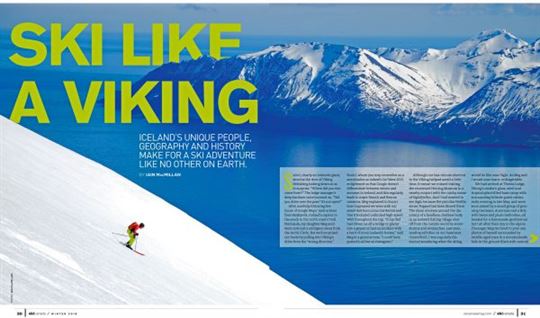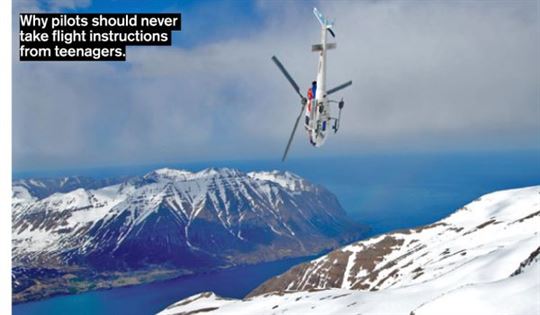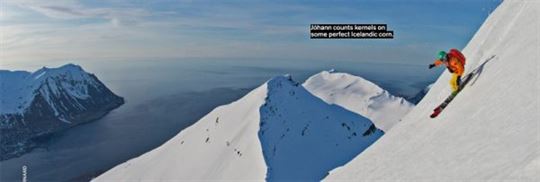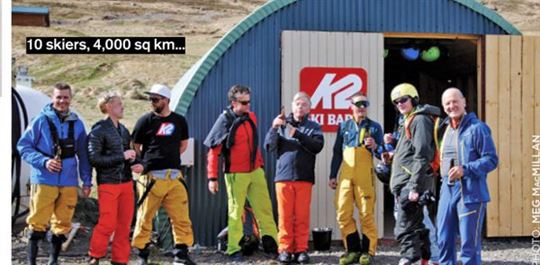Iceland’s unique people, geography and history make for a ski adventure like no other on Earth.
by IAIN MACMILLAN in the Winter 2018 issue

Snorri, clearly an Icelandic giant, stood at the door of Viking Heliskiing looking down at us in surprise. “Where did you two come from?” The lodge manager’s deep baritone voice boomed on, “Did you drive over the pass? It’s not open!”
After carefully following five hours of Google Maps’ instructions from Reykjavík, Iceland’s capital, in the south to the north coast’s Troll Peninsula, my daughter Meg and I were now just a smidgeon away from the Arctic Circle. But we’d surprised our hosts by pulling into Viking’s drive from the “wrong direction.” Snorri, whom you may remember as a semifinalist on Iceland’s Got Talent 2012, enlightened us that Google doesn’t differentiate between winter and summer in Iceland, and this regularly leads to major Search and Rescue missions. Meg explained to Snorri how impressed we were with our sweet 4×4 from Lotus Car Rental and that it included unlimited high-speed WiFi throughout the trip. “If my dad had driven us off a bridge or glacier into a geyser or had an accident with a herd of iconic Icelandic horses,” said Meg in a genuine tone, “I could have posted it all live on Instagram.”
Although our last-minute shortcut to the Viking helipad saved a little time, it meant we missed visiting the renowned Herring Museum in a nearby outport with the catchy name of Siglufjörður. And I had wanted to see Siglu because the peculiar Netflix series Trapped had been filmed there. The show revolves around the discovery of a headless, limbless body in an isolated fishing village shut off from the outside world by snowstorms and avalanches. Last year, reading subtitles on our basement chesterfield, I was regularly distracted wondering what the skiing would be like near Siglu. As Meg and I would soon learn: unforgettable.
We had arrived at Thvera Lodge, Viking’s modern glass, steel and tropical-plant-filled base camp with surrounding hillside guest cabins, early evening in late May, and were soon joined by a small group of grinning Germans, Austrians and a Brit, with beers and plush bathrobes, all headed for a homemade geothermal hot tub after their day in the alpine. (Teenager Meg declined to post any photos of herself surrounded by middle-aged men in a mountainside hole in the ground filled with natural hot water.) But in the small-world department, friend and mountain guide Stefan Kreuzer, an amiable German-Canadian, joined us in the hole. I know Stefan through his guiding work with Selkirk Snowcat Skiing in B.C.’s Kootenays. When the powder season starts wrapping up in Canada, it’s just getting underway in Iceland, so Stefan chooses to bolt for this mid-Atlantic paradise to extend his season.
A few steps behind Stefan et al were Viking’s founders and owners Jóhann Hafstein and Björgvin Björgvinsson, certainly the two coolest Icelanders I’ve ever met.
Until 2012, Björgvin was the reigning national slalom champion for many years, although in his slight but distinctly Icelandic accent, quiet-spoken Jóhann informed me that he’s beaten Björgvin in both GS and slalom “many times.” The pair, both 38, have been besties since they were 10 years old, have raced in the Olympics three times, as well as hunted, fly-fished, sailed, biked and ski-toured together, all over their diminutive but spectacular country. Björgvin and his honey, Harpa, have three bouncy boys; Jóhann has a daughter, and his pregnant wife, Sandra, makes regular trips to Toronto and Montreal as a commercial airline pilot with WOWair. I felt quite humbled.
When I asked how deep their families’ Icelandic roots go, I was confused by Jóhann’s response. “About 870” sounds more like a street address than “in the year of our Lord,” but forebears of both the Hafsteins and Björgvinssons arrived with Ingólfr Arnarson and the first Norse settlers from Scandinavia—around 870 A.D. Viking Heliskiing launched 1,142 years later; 2018 is its 5th season. As I lay in bed that night with the blinds drawn to darken the midnight sun, it dawned on me that the next day Meg and I would be heli-skiing with descendants of Vikings. I yelled at Meg in the next room, asking when an appropriate time would be for me to send friend requests on Facebook.

It felt surreal the next morning with Stefan going through beacon training and a safety talk in Iceland, having given us something very similar at Selkirk Snowcat Skiing. (I also fell for his foot-on-the-weigh-scale joke again.) Stefan introduced us to our good-looking Swiss pilot Nico, who’d flown in places like Iraq. Our takeoff spot was about 10m from the breakfast table, and within a few whoop-whoop-whoop minutes later we were headed toward a magnificent seascape banked along the way by equally impressive mountains on both sides.
Soon we were flying over the geothermally heated, year-round soccer pitches and outdoor waterpark in the town of Ólafsfjörður, which lies on the other side of a massive under-mountain tunnel from Siglufjörður and its Herring Museum, sort of Iceland’s version of Springfield and Shelbyville I imagine. What was available for skiing was strikingly obvious. With a tenure of 4,000 sq km, Jóhann and Björgvin are still leading guests down first descents, sometimes with verticals of up to 1,500m.

Unlike the current über-winter that’s burying the Alps, last year’s was an exceptionally mild one for much of Europe, and Iceland’s warmest in nearly 100 years. Where a “normal” ski season runs from late February to late June, we were learning that enormous swaths of terrain were no longer skiable right down to the sea. I suddenly feared slush bumps, and momentarily forgot I was discussing snow conditions with perfectionists who live and breathe the best.
And so, on a perfectly cloudless cool spring morning, four of us and Jóhann piled out of the idling A-Star into boot-top light dry wintry powder that had arrived a day earlier, erasing any hint that these slopes had been skied all winter. Not a breath of wind, -4 degrees, a world away from the hordes of tourists near Reykjavík. The Vikings had delivered.
Our giggling group watched Nico swerve and drop from the sky to collect Stefan and the other four when silence, and reality, set in. “Greenland’s right over there Meg,” I said, not entirely sure I was directionally correct. Even in a teenager’s mind, I could tell the enormity of the sea, sky and mountains was imposing. Pointing out that we were well north of Iqaluit’s latitude was less impressive. But the scenery was just so massive we almost had to be reminded what our mission was.
The result of Iceland’s millennium of deforestation is striking, especially to a Canadian. On our drive up the west side of the island the day before we saw virtually no trees, apart from a few planted in towns and on farms, fenced off from grazing sheep. There are, of course, some small forested areas of Iceland, but from where we stood with our mouths open, the lack of trees, and perhaps more important the lack of cliffs, made practically everything look skiable. Jóhann agreed and added that there are still slopes that have never been skied.
We didn’t bag any first descents but we played like puppies repeatedly, leaving our five sets of tracks on enormous, wide-open faces with the omnipresent distracting sea views of Eyjafjörður, the fjord in the background. As time and laps wore on, our earlier south-facing turns moved to more westerly and finally north-facing as Jóhann and Nico followed the rotating never-setting sun that warmed our powdery palette. Winter snow turned to some of the best corn I’ve ever skied, perfectly set on untouched slopes so smooth they could have hosted speed ski trials. In steeper sections, niblets rushed ahead of our skis with a sound that intrigued more than intimidated Meg.
Making hay while the sun shines is certainly part of any heli-ski operation, where changes in weather can affect minimum verticals skied, and with daylight virtually 24 hours at this time of year, everyone was happy to stay late with a “that was great…let’s just do one more” attitude. We weren’t fully able to ski from sky to sea given the aforementioned warm winter of 2017, but lying in the warm sunshine on a bouncy bed of heather about 100m above the shore at lunchtime had no one complaining.
Viking’s weather-delay options must certainly be the most unique in the world, from whale watching aboard the company’s motor yacht to tours of astonishing geological wonders (including quiet “blue lagoon”-style steamy swimming centres where lifeguards serve beer), horseback riding, scuba or surfing. As well, no-fly days don’t necessarily mean no-ski days; the largest box-cat I’ve ever seen is at Viking’s disposal.
Returning home the first day, snow and scenery satiated, I inquired about our deck’s dry hot tub. Stefan popped by our cabin to fix the situation…by turning on the tap. The concept of free hot water simply pouring out of pipes from the hillside is such a shock. “When it gets too hot, just add some cold,” said Stefan, “but don’t turn off the hot water, just let it slowly overflow.” Definitely my first chemical-free hot tub experience, and not a whiff of sulphur. Many parts of Iceland have this virtually free source of energy, whether it’s to heat their homes or use in heavy industry. Incredible.
Icelandic culinary skills were equally impressive. During our visit, we dined graciously on gourmet goose shot by Björgvin and Jóhann, lobster and Arctic char caught by fishermen a few kilometres away, and lamb raised nearby. After our decadent dinners and worldly conversations, we drank Viking beer while Snorri sang Icelandic tunes and entertained us on the guitar.
Trying to photograph a skiing Viking, and Olympian, proved an elusive goal in such a short visit. The next day I chased Jóhann around with the camera, but found his style too fast and too smooth to match his impressive CV. But it’s hard to take a bad photo of Iceland’s natural beauty. I seemingly took my camera strap off when I went to bed and put it back on when I got up in the morning.
Although the Vikings managed to pack three glorious days’ worth of vertical into two, our plans to ski under the midnight sun were sadly scuttled by fog that rolled in on our final evening. A regular extravagance for guests in May and June, “night” skiing can also be considered a trade-off. Choosing to ski when it’s light at midnight means you’ve lost the opportunity to visit earlier in the season when après-ski and evening hot-tub soaks are most certainly done under the surreal northern lights. The only option we can think of is to ski with the Vikings twice a season.

VIKING VITALS
WOWair has daily six-hour flights between Keflavik and Montreal or Toronto. A week before our departure, a return fare, including bags and all taxes, was about $450. WOW’s sales are legendary, with airfares between Canada and Europe as low as $300 with all taxes in. We found the service excellent, too. wowair.ca
Viking Heliskiing offers 2-7 day, semi-private and private adventures (four skiers, 1 or 2 guides), including minimum flight times, all gourmet meals, snacks, new K2, BCA and Salewa gear, private whale watching or other tours, and Akureyri Airport transfers. Season: March 6-June 6, 2018. vikingheliskiing.com
Scandic Mountain Guides offers internationally certified mountain guides for ski-touring adventures (as well as heli- and yacht-assisted) all over Iceland. And if you can pronounce the ski resort names, like nearby Hlíarfjall, get your warm-up laps in or start your touring adventure from the top lift. We left this adventure for our next trip. scandicguides.com
A night in Reykjavík
Splurge at the Reykjavík Marina Residence: a handful of luxe Icelandic-designed suites in a restored private home at the city centre and harbour. reykjavikmarinaresidence.is
Lotus Car Rental may be one of seemingly hundreds of options in Iceland but the only one we could find that included unlimited WiFi. Lotus also offered all new vehicles and is right at the airport. The drive from Reykjavík to Viking is about five hours, but expect 1,000 photo-stops along the way. A 45-minute flight is an option and requires transferring between international and domestic airports as well as a one-hour (included) transfer from Akureyri to Viking’s HQ. lotuscarrental.is